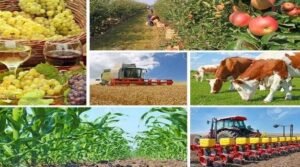Diversification in agriculture
In the agricultural context, diversification can be regarded as the re-allocation of some of a farm’s productive resources, such as land, capital, farm equipment and pieces to other farmers and, particularly in richer countries, non-farming activities such as restaurants and shops.
Factors leading to decisions to diversify are many, but include; reducing risk, responding to changing consumer demands or changing government policy, responding to external shocks and, more recently, as a consequence of climate change.

Two approaches to crop diversification in agriculture:
Horizontal diversification-
The primary approach to crop diversification used in production agriculture. In this approach, diversification normally takes place through crop intensification which means adding new high-value crops to existing cropping systems as a way of improving the overall productivity of a particular farm or a region’s farming economy as a whole.
Vertical diversification-
It is an approach in which value is added to the products by farmers through various methods such as processing, regional branding, packaging, merchandising, or other efforts to enhance the product.
Need of agriculture Diversification-
- A substantial portion of Indian farming is dependent on the vagaries of monsoon, making it is risky affair to rely upon solely.
- Accordingly, the need of diversification is required to enable the farmers to earn from other alternatives non farm occupation.
- The kharif season opens up ample opportunities for agriculture employment. However, owing to lack of irrigation facilities, the farmers fails to get gainful employment opportunities during the Rabi season. Therefore the need of diversification arises during the Rabi season.
- Agriculture being over crowded cannot further generate employment opportunities. Therefore, the prospects of the non farm sector should be opened up in the rural area to provide job opportunities, diverting workforce from the already crowded agriculture sector.
- The non farm sector has several segments that posses dynamic linkages such enhance the healthy growth of an economy.
The important facts highlighting the need of crop diversification in India-
- For raising farm income.
- Sustainable production and income.
- Food and nutrient security.
- Promotion of export.
- Employment generation.
- Poverty alleviation.
- Judicious use of land and water resources.
- Reduction in environmental pollution.
Crop diversification as strategy for issues of natural resources management-
Water is important natural resource which is facing several challenges and there are several concerns regarding water resources in the country and the states.
- Judicious use of land and water resources will have to be the central theme for sustainability of agricultural growth.
- The deterioration in land and water resources has been in the form of land degradation, water logging and decline in water table.
- There are several possible technologies and alternatives to reduce the use of chemicals in agriculture. These alternatives are not perfect substitutes to chemicals but adoption of these can substantially reduce the adverse impact on environment.
- Proper land and water management policies would reduce environmental degradation.
- Community and village level farmer’s institutions have to be encouraged to participate in protecting natural resources from degradation. Programmes for regeneration of land and water resources need to be strengthened.
Presented by–
Ravi Kumar
Amity University, NOIDA
B.sc (H) Agriculture


